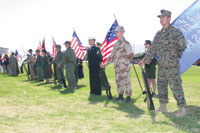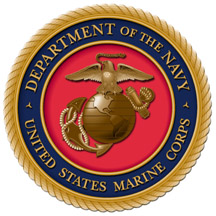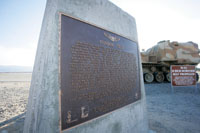|
|
  
As the country’s defense needs have evolved over the years, so have the training expectations and training facility needs. The evolution from Camp Detachment Marine Corps Training Center in 1952 to Marine Corps Air Ground Combat Center in 1978 document the changing times and the Marine Corps’ response to those changes. On October 1, 2000, the command at the Marine Corps Air Ground Combat Center was assigned an additional mission as the Marine Air Ground Task Force Training Command. Because the base is referred to as MCAGCC (pronounced
Ma-CAG’-Cee), the change has been transparent to most of the Marines, Sailors, families, units and community. Marines and Sailors directly assigned to MCAGCC provide logistical and administrative support to service members and their families stationed here, as well as visiting units who travel to Twentynine Palms from all over the globe for training. MAGTFTC’s sole mission is to conduct relevant training in live-fire combined arms, urban operations and Joint/Coalition level integration that promotes operational forces’ readiness.
In 1950, the nation became involved in the Korean War. As the need for live-fire training grew along with the swelling ranks, it became obvious that more ranges were in order. Pendleton’s Marines looked inland toward the desert and happened upon the abandoned Condor Field, a World War II Army glider base located about five miles north of the town of Twentynine Palms, Calif. On August 20, 1952, Camp Pendleton Base Headquarters issued Post Order 343, and Marine Corps Training Center, Twentynine Palms, Calif, was born.
The base has undergone numerous changes. Since its beginnings, many hundreds of thousands of Marines have prepared for war here, practicing their war fighting skills in the challenging terrain and climate of the Mojave Desert. In the early days it was primarily seen as a place
for artillery units to unmask their devastating firepower in training.
Subsequently, it has been home to numerous tenant commands, earning a reputation as the premier combined-arms training facility in the
Marine Corps.
Only 70 Marines comprised the initial Marine detachment at the Center. Manned by Camp Pendleton Marines, its primary mission was to prepare the new base for the arrival of permanent personnel. By mid-December 1952, a fresh 3rd Marine Division with assistance from the 12th Marine Regiment conducted the first large-scale, live-fire field exercise aboard the new base. This “FEX-1” gave Marines a glimpse of the facility’s potential and foreshadowed the large-scale combined-arms exercises for which the base is now famous.
In 1976, under the command of Brigadier General Ernest R. Reid, Jr., work began to add an expeditionary airfield to the base’s growing infrastructure. When the first C-5 Galaxy cargo jet landed in August 1978, it was apparent that the air-ground capability of the base was complete. It also was during this time that plans for large-scale Combined Arms Exercises were conceived. Supplanting an earlier exercise known as “Desert Palm Tree,” the new CAXes were remarkable in two respects: the practice of combined arms and live fire and movement during the exercises were unprecedented in scale. Just as noteworthy was the creation of a Tactical Exercise Control Center with the primary purpose of controlling, instructing and critiquing the exercises. In the words of base historian, Colonel Verle E. Ludwig, USMC (ret.), “Twentynine Palms was to be a permanent combined-arms exercise college for all of the Marine Corps.”
Throughout its short but illustrious history, the base was known by five previous names. Officially christened in 1952 as the Camp Detachment Marine Corps Training Center, Twentynine Palms, Calif., it was redesignated February 6, 1953, as the Marine Corps Training Center, Twentynine Palms. By February 1, 1957, it grew to base status and was again redesignated as Marine Corps Base, Twentynine Palms, Calif.
Following completion of the expeditionary airfield, its name was changed to Marine Corps Air Ground Combat Training Center on October 1, 1978, and changed to Marine Corps Air Ground Combat Center on February 16, 1979.
On October 1, 2000, after 21 years MCAGCC was given its additional MAGTFTC mission. This redesignation accompanied a change in policy
that placed MAGTF Training Command under the auspices of Training and Education Command, Marine Corps Combat Development Command, Headquarters Marine Corps, Marine Corps Base, Quantico, Va. This arrangement simplified what was occasionally a complicated chain of command, and promised to further enhance the base’s ability to fulfill its primary mission of providing the highest quality training for units that train here, and to provide the highest quality support to the units, Marines, Sailors and families that call it home.
The growth of the base has paralleled growth of the surrounding community. Throughout the years, the vibrant and vital relationship between the base and the City of Twentynine Palms and other Hi-Desert communities has been a source of comfort and pride to the command. From those early days when the survival of 70-odd Marines depended almost solely upon what the budding town provided, to today, the relationship has always been one of mutual respect and support.
With direct threats to our nation more probable today than ever before, and the perpetual need to train Marines realistically and safely for that inevitable occasion when they will be called upon to protect it, the importance of the base at Twentynine Palms to that readiness is as apparent as it has been for the last half century. MCAGCC’s service members and civilian employees remain committed to providing the best training available in the world to Marines and working hand-in-hand with the community of which it is proud to be a part in achieving that goal.
The Twentynine Palms Installation Guide is published by Benchmark Publications Incorporated, a private firm in no way connected with the U.S. Marine Corps, under exclusive written contract with the Marine Corps Air Ground Combat Center, Twentynine Palms. The appearance of advertising in this publication, including inserts and supplements, does not constitute endorsement by the U.S. Marine Corps or Benchmark Publications Incorporated of the products or services advertised. Everything advertised in this publication shall be made available for purchase, use or patronage without regarded to race, color, religion, sex, national origin, age, marital status, physical handicap, political affiliation or any other non-merit factor other purchaser, user or patron.
If a violation or rejection of this equal opportunity policy by an advertiser is confirmed, the publisher shall refuse to print advertising from that source until the violation is corrected. The Twentynine Palms Guide is an unofficial publication authorized by AR 360-1. Editorial content is prepared, edited and provided by the Public Affairs Office of MCAGCC, Twentynine Palms.
|
|